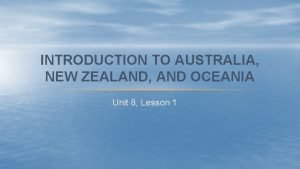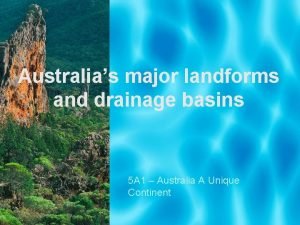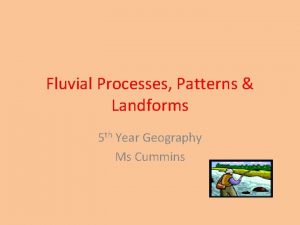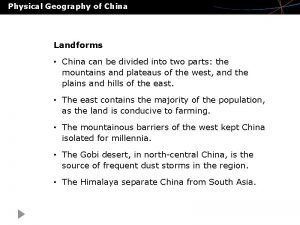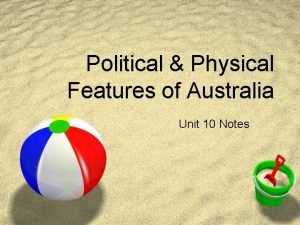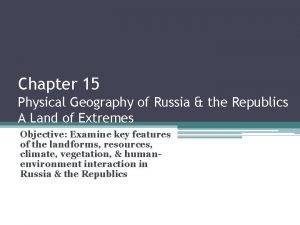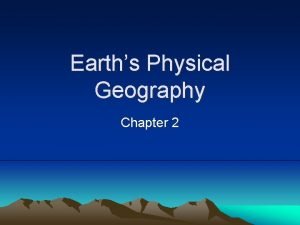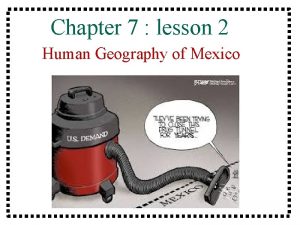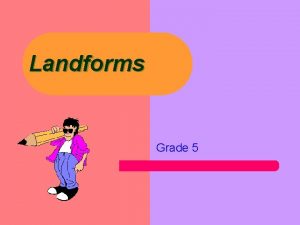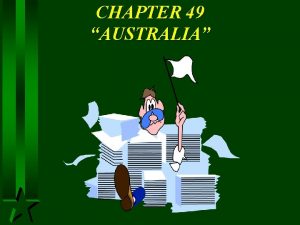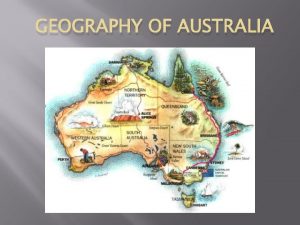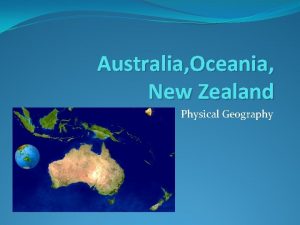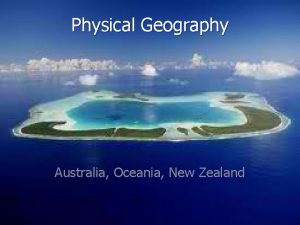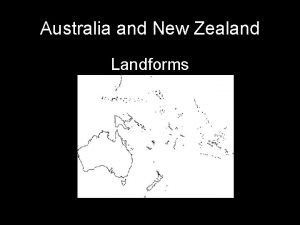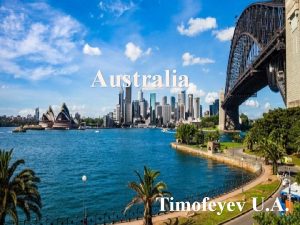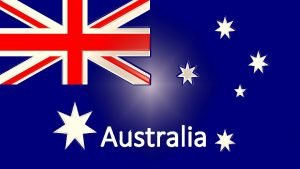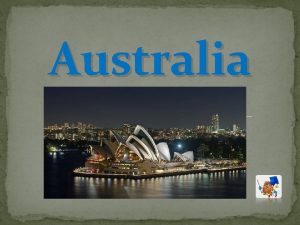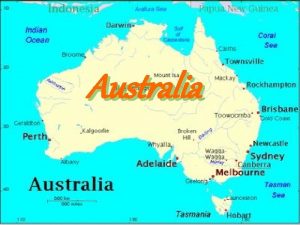CHAPTER 49 AUSTRALIA I PHYSICAL GEOGRAPHY A LANDFORMS
















- Slides: 16

CHAPTER 49 “AUSTRALIA”

I. PHYSICAL GEOGRAPHY A. LANDFORMS 1. Australia is the world’s smallest continent. 2. It can be divided into three major landform regions. a. Western Plateau b. Central Lowland c. Eastern Highlands

B. CLIMATE 1. About half of Australia has a desert climate. a. This area covers much of the interior and extends to the coast of Western Australia. 2. A tropical-savanna climate is found on the northern coast of the Northern Territory and the Cape York Peninsula of Queensland.

3. There is a small area of humidtropical climate and rain forests in the far northeastern corner of coastal Queensland. 4. Most of coastal Queensland New South Wales has a humid-subtropical climate. 5. Farther south, a marine-west-coast climate prevails. 6. The southwest coast of Western Australia has a Mediterranean climate.

C. WATER RESOURCES 1. Long dry spells cause severe water shortages, brush fires, and dust storms. 2. The Murray-Darling river system is the only major river system in Australia. 3. The largest underground well water lies in the Great Artesian Basin of interior Queensland, but much of this water is poor quality.

D. BIOGEOGRAPHY 1. Biogeography is the study of the geographic distribution of plants and animals. 2. Because of its island location, many of Australia’s animals and plants are found nowhere else in the world. 3. Australia is known for its marsupials, such as the kangaroo and the koala.

4. More than 500 species of eucalyptus are found in Australia. a. More than 90 percent of Australia’s trees are some variety of this plant. 5. Many plants and animals were introduced to Australia by humans. a. The Aborigines brought the dingo, a dog from Asia. b. Europeans introduced sheep, rabbits, foxes, water buffalo, birds, and hundreds of plants.

6. Managing Australia’s unique wildlife is a source of concern and controversy to the country’s people. E. The Great Barrier Reef 1. The Great Barrier Reef is located in the Coral Seas off the northeastern coast of Queensland. 2. At 1, 200 miles long, it’s the world’s largest coral reef. 3. The Great Barrier Reef is the home to the world’s greatest variety of ocean life.

II. ECONOMIC GEOGRAPHY A. Agriculture 1. Australia produces about 1/3 of the world’s wool supply, which is mainly exported to Japan and China. 2. Australia is the world’s leading beef exporter. 3. Only about 6 percent of the land is used for farming, but Australia is selfsufficient in food and is a major food exporter.

4. Wheat is the nation’s major crop and covers more than half of the cropland. 5. Australia’s other major export crops are sugar, rice, and cotton. B. MINERAL RESOURCES 1. The Outback is a storehouse of mineral wealth. 2. Australia is a world leader in the exporting of iron ore, bauxite, and coal. 3. Australia is a leader in the production of diamonds and opals.

4. Australia has vast uranium reserves. 5. Australia’s energy resources. a. Produce about 70 percent of the country’s oil. b. Huge natural gas reserves discovered off the northwest coast. c. Most coal mining in eastern Australia. C. INDUSTRY 1. Most of Australia’s industries are now in decline.

2. Service industries are becoming the country’s major employer. 3. Tourism and entertainment are rapidly growing industries. D. ASIAN-PACIFIC CONNECTIONS 1. Asian countries make up Australia’s largest market. 2. Japan is a major customer for crops, meat, and minerals.

III. POPULATION GEOGRAPHY A. URBAN GEOGRAPHY 1. More than 85% of all Australians live in urban areas. 2. Australia’s cities are generally clean and have low crime rates. 3. The country’s three largest cities, and most of its population, are found in the southeastern corner of Australia. a. Sydney is the capital of New South Wales.

b. Melbourne is Australia’s second largest city. c. Brisbane is Australia’s third largest city. B. Aborigines 1. Were the first inhabitants of Australia. 2. They migrated from Southeast Asia about 50, 000 years ago. 3. Many died from diseases brought by the Europeans. 4. Most live in poverty in urban areas.

C. ISSUES 1. Some Australians are opposed to immigration growth, which over the past 40 years helped double the country’s population. 2. Environmental concerns such as urban smog, mining, damming of rivers, and forests destruction threaten Australia’s unique environment. 3. Wind erosion of topsoil and salinity have also become serious problems.

POSSIBLE ASSIGNMENTS: 1. Australia Map 2. Australia Videodisc 3. Challenge/Enrichment (Chapter 49 pg. 5, 6) 3. Make a Colleague on Australia 3. Section Review (pg. 606, 607, 610) 5. Building a Voc, Recalling and Reviewing, Thinking Critically (pg. 611) 6. Using the Five Themes of Geography (pg. 611)
 Lesson 1: an introduction to oceania
Lesson 1: an introduction to oceania Major landforms in australia
Major landforms in australia Fluvial processes diagram
Fluvial processes diagram China physical landforms
China physical landforms What are some of africa’s distinctive landforms?
What are some of africa’s distinctive landforms? Mariana trench
Mariana trench Political features of australia
Political features of australia Absolute location of australia
Absolute location of australia Which landform is a high broad level plateau in australia
Which landform is a high broad level plateau in australia Chapter 27 section 1 landforms and resources
Chapter 27 section 1 landforms and resources Russia and the eurasian republics physical map
Russia and the eurasian republics physical map Chapter 15 lesson 1 physical geography of north africa
Chapter 15 lesson 1 physical geography of north africa Definition of eastern europe
Definition of eastern europe Earth's physical geography chapter 2
Earth's physical geography chapter 2 What influenced mexico’s political and social structures
What influenced mexico’s political and social structures States west of the mississippi
States west of the mississippi Chapter 8: the physical geography of latin america answers
Chapter 8: the physical geography of latin america answers
